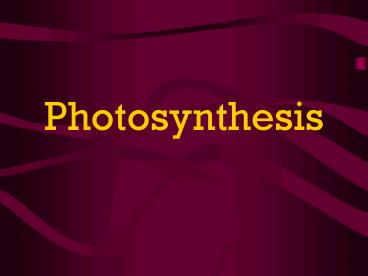Photosynthesis - PowerPoint PPT Presentation
1 / 64
Title:
Photosynthesis
Description:
Single layer of cells that covers the upper and lower surface. Stomate ... Broken down into 2 layers- palisade and spongy. Palisade Mesophyll ... – PowerPoint PPT presentation
Number of Views:300
Avg rating:3.0/5.0
Title: Photosynthesis
1
Photosynthesis
2
Definition
- Conversion of light energy into chemical energy.
3
6CO2 6H2O ? C6H12O6 6O2
4
Leaf Structure
5
Cuticle
- Waxy covering that is secreted by the epidermal
cells.
6
Epidermis
- Single layer of cells that covers the upper and
lower surface
7
(No Transcript)
8
Stomate
- Minute pores in the epidermis through which gases
diffuse.
9
Guard Cells
- Surround the stomates.
- When filled with water, they swell and open the
stomate.
10
(No Transcript)
11
Mesophyll
- Middle section of leaf.
- Broken down into 2 layers- palisade and spongy.
12
Palisade Mesophyll
- Filled with tall, skinny cells containing lots of
chloroplasts.
13
Spongy Mesophyll
- Cells are more spread out to create air pockets.
14
Vein
- Transports water and food.
15
(No Transcript)
16
Chloroplasts
17
Stroma
- The liquid solution that fills the space.
18
Grana
- Stacks of thylakoids.
- Maximize surface area.
19
Thylakoid
- Flattened sacs in the chloroplast.
20
Photosystems
- Embedded in the thylakoid membrane
21
Photosystems
- Made of Light Harvesting Complexes (containing
pigments) that surround a Reaction Center
(containing 2 chlorophyll a molecules and a
primary electron acceptor)
22
(No Transcript)
23
Pigments
- Molecules that absorb some wavelengths of light.
24
Pigments
- Each pigment absorbs light at a specific
wavelength. - Chlorophyll a- all green plants.
25
Pigments
- Accessory pigments (chlorophyll b, beta carotene,
etc.) collect light energy and transfer it to
chlorophyll a OR dissipate extra energy
26
Reaction Center
- P700 (Photosystem I) has a chlorophyll a whose
absorption peaks at 700 nm - P680 (Photosystem II) peaks at 680 nm
27
(No Transcript)
28
Review
- Why are green plants green?????
29
The electromagnetic spectrum
30
(No Transcript)
31
Overview of Photo.
- Energy Capture
- Fixing Carbon
32
Light Reactions
- Occurs across thylakoid membranes.
33
Light Reactions- Summary
- Pigments absorb light energy.
- Electrons jump to higher states
- Electron Transport Chain forms ATP and NADPH
34
Noncyclic Electron Transport
- 4 major steps (beginning from the end)
- Photosystem I loses an electron which helps
reduce NADP to NADPH
35
Noncyclic Electron Transport
- 2. Photosystem II loses an electron (via an
E.T.C.) to Photosystem I. - This also puts H into the thylakoid
36
Noncyclic Electron Transport
- 3. Water is split into Oxygen, H and electrons.
- Electrons replace those lost by Photosystem II
- H are put into thylakoid
37
Noncyclic Electron Transport
- 4. All the H in thylakoid diffuses through ATP
synthase, which makes ATP.
38
BUT.
- More ATP is needed for the Calvin Cycle so..
39
Cyclic Electron Flow
- Electron in Photosystem I gets a boost.
- Energy is used to put more H into thylakoid.
- Electron goes back to Photosystem I
40
Cyclic Electron Transport
- 4. All the H in thylakoid diffuses through ATP
synthase, which makes ATP.
41
Calvin Cycle
- Purpose
- To use chemical energy made in light reactions to
make G3P
42
Calvin Cycle
- 3 molecules of carbon dioxide combines with 3
molecules of RuBP to form 3, 6-carbon sugars.
The enzyme that combines them is called Rubisco.
43
Calvin Cycle
- Each 6 carbon sugar splits into 2, 3-carbon
sugars each called PGA
44
Calvin Cycle
- ATPs and NADPHs are used to convert each PGA
into G3P (now have 6 G3Ps)
45
Calvin Cycle
- One G3P is released from the cycle
- More ATP is used to convert the remaining 5 G3Ps
into 3 RuBPs
46
Calvin Cycle
- G3P is used to make glucose, starch, amino acids
(by adding NH3) lipids, etc.
47
(No Transcript)
48
3- C (3 CO2)
18- C (6 G3P)
15- C (3 RuBP)
3- C (1 G3P)
49
Photorespiration
- Instead of
- 6CO2 6 RuBP ? 2 G3P
- You Get
- 6O2 6 RuBP ? 1 G3P 1 glycolate
50
Photorespiration
- Glycolate is a 2 carbon acid later converted to
CO2
51
Photorespiration
- When? Why?
52
C4 Pathway
- An adaptation to reduce photorespiration and
maximize photosynthesis
53
C4 Pathway
- Examples- Sugar Cane, Corn, etc
- Conserves CO2 by fixing it with a middle man
54
C4 Pathway
- Surrounding each vein is a layer of tightly
packed cells called the bundle sheath
55
C4
C3
56
C4 Pathway
- Mesophyll cells surround bundle sheath (but do
not contain rubisco, like in C3 plants)
57
(No Transcript)
58
C4 Pathway
- These cells fix CO2 with a 3-carbon acid to form
a 4-carbon acid (oxaloacetate) - Oxaloacetate is rearranged to malate and
transported to bundle sheath cells
59
C4 Pathway
- There, the acid releases a CO2, which enters the
Calvin Cycle
60
C4 Pathway
- C4 plants grow very rapidly
61
CAM Plants
- Examples- Jade, Cactus, etc
- Another way of conserving carbon dioxide by
giving it to a middle man
62
CAM Plants
- Open stomates at night and incorporate CO2 into
organic acids (like C4 plants)
63
CAM Plants
- Enzymes break down the organic acids releasing
CO2, which then enters the Calvin Cycle - During the day, stomates close to conserve water
64
CAM Plants
- Not very efficient- CAM plants grow very slowly































